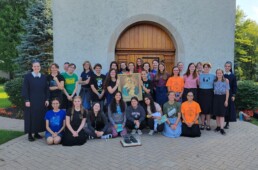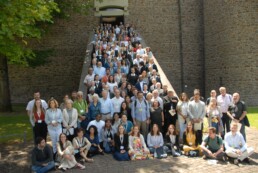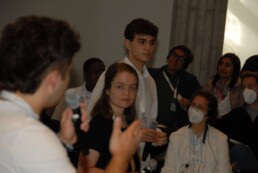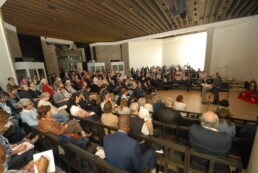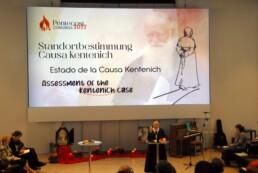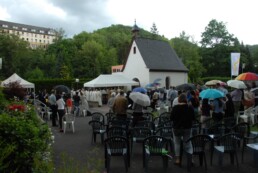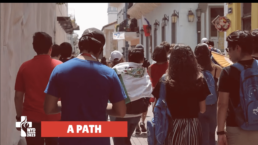Ver Sacrum Patris - A Stream from the USA Girls' Youth
Schoenstatt Girls and Young Women
Every year, the leaders of the Schoenstatt Girls and Young Women are invited to the international Retreat Center in Waukesha, Wisconsin, for the annual Leaders’ Convention. The convention is always held at the beginning of August, after summer camps in each state are over, and it typically lasts three days. This convention is a time when we come together to discuss the past year, experience fellowship, and formulate an effective and motivating motto for our striving for the coming year. It is also a time of training on a national level. During the convention each year, the leaders also make a mini-pilgrimage to Milwaukee, a thirty-minute drive, to visit the Exile Shrine and the Movement house. For many leaders, this is a time when they can experience, some for the first time, the places where Father Kentenich lived and worked during the years of his exile.

This meeting is a time of prayer, discussion, and discernment
All leaders in the SGYW branch in the USA are invited to come. These are the youth leaders of the branch, typically ages 16-22. There are three main areas in the United States with established youth branches: the Wisconsin-Illinois area, Minnesota, and Texas. Typically, there are many leaders from each of these states, and this year we welcomed leaders from Florida! The convention is moderated by the national team, the state leaders from each of the three main areas.
This meeting is a time of prayer, discussion, and discernment. Each day begins with Mass and morning prayer in the Shrine, followed by a meditation. The discernment process then begins with a look at the needs and signs of the times in general and then for young women in particular. Looking at these signs, the leaders break off into smaller groups and discuss the main problems that they see the youth struggling with and ways that Schoenstatt could provide an answer to these difficulties. They review the strivings and struggles of the past year, as states or regions, to see what inspired the youth and what areas need to be improved or approached in a different way. Then they come together to share their experiences and ideas.
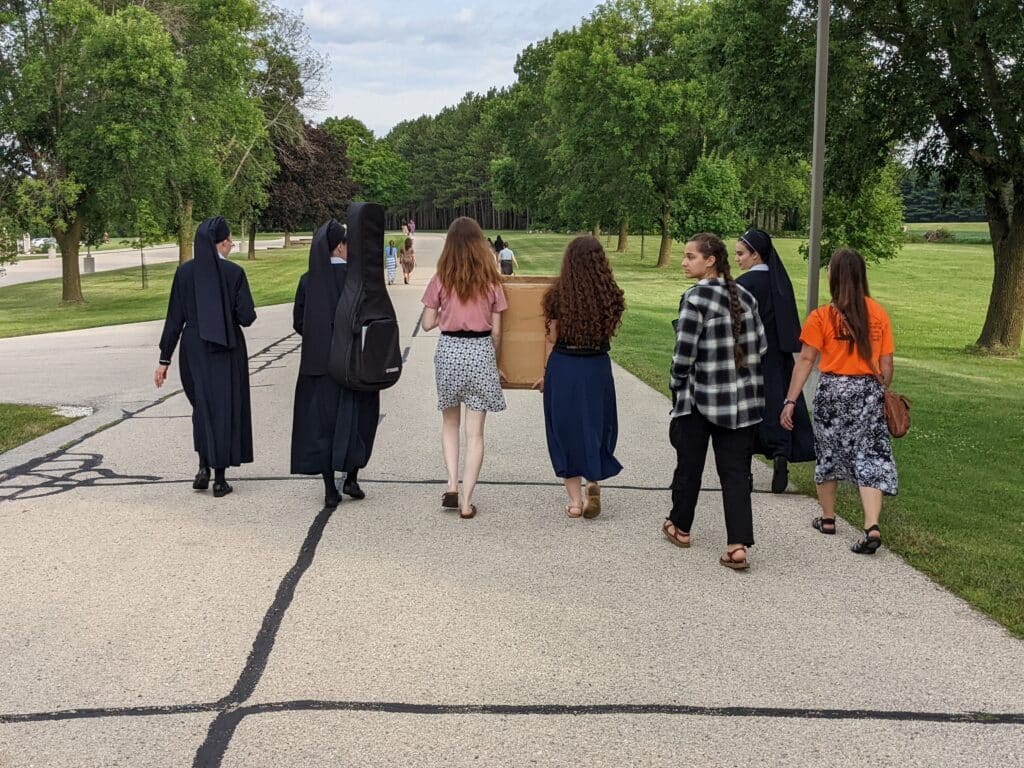
Formulation of the new motto
From these streams and experiences, the young women then try to formulate a new motto that will express the striving and mission that they are called to carry out in the coming year. It is a very synodal process as each one must practice humble, open listening as well as boldness in sharing what is on her heart. Each year’s motto is a short expression that is meant to capture and convey the Girls’ and Young Women’s answer to the needs of the times from where they are in life. This motto becomes each one’s mission statement for the coming year, her mission to the girls she leads but also to all those she comes into contact with.

Our previous motto was: “Rekindle the Springtime.” The pandemic hit the girls youth in the USA really hard. These past two years have been a real time of testing, so we took comfort in the stability of those who were able to continue working for the branch. With this motto, we strove to strengthen our own inner fire for Schoenstatt and the Blessed Mother so that we could draw others to her through our Apostolate of Being.
We have worked interiorly to strengthen our self-education, and now the Blessed Mother is sending us out. Our new motto is: Covenant daughter, raise your eyes and dance. Here is the explanation of our motto from the national team:
“What does it mean to be a woman today? We find our identity as a covenant daughter, a daughter of the King and Queen. This security invites us to raise our eyes and our hearts to the heights, full of childlike trust in God and the Blessed Mother. The uplifting nobility of our being will permeate our surroundings and invite others to look heavenwards as well. We raise our eyes because we have unlimited hope and confidence that the heavenly Father will never lead us astray but transform us into more perfect reflections of himself. This certainty fills us with a contagious joy, a joy that we long to share with others, a joy that makes us dance! It is this joy in our faith that we as Schoenstatt Girls and Young Women are commissioned to share with others through our latest year’s motto.”
“Let them praise his name with dancing and make music to him with timbrel and harp. For the Lord takes delight in his people; he crowns the humble with victory.” ~Ps. 149
Pentecost Congress: June 12 – Send Us Out from Here
The members of the reflection team worked hard into the night on Saturday preparing the final version of the memorandum. It would incorporate everything that the congress participants had been discussing for the past four days. Then Sunday, the feast of the Holy Trinity, began with the reading of the finalized memorandum.
“You Are Our Letter”

Father Felix Geyer presented the memorandum to the congress in the morning. The memorandum addressed these main points: Father Kentenich and his cause, Schoenstatt’s charism, and Synodality withing Schoenstatt and the Church. The memorandum was very well received. Everyone felt that it perfectly expressed and addressed everything that the congress had brought forward, and with a few suggestions for improvement, it was unanimously approved.
“Not on Tablets of Stone but on Human Hearts”
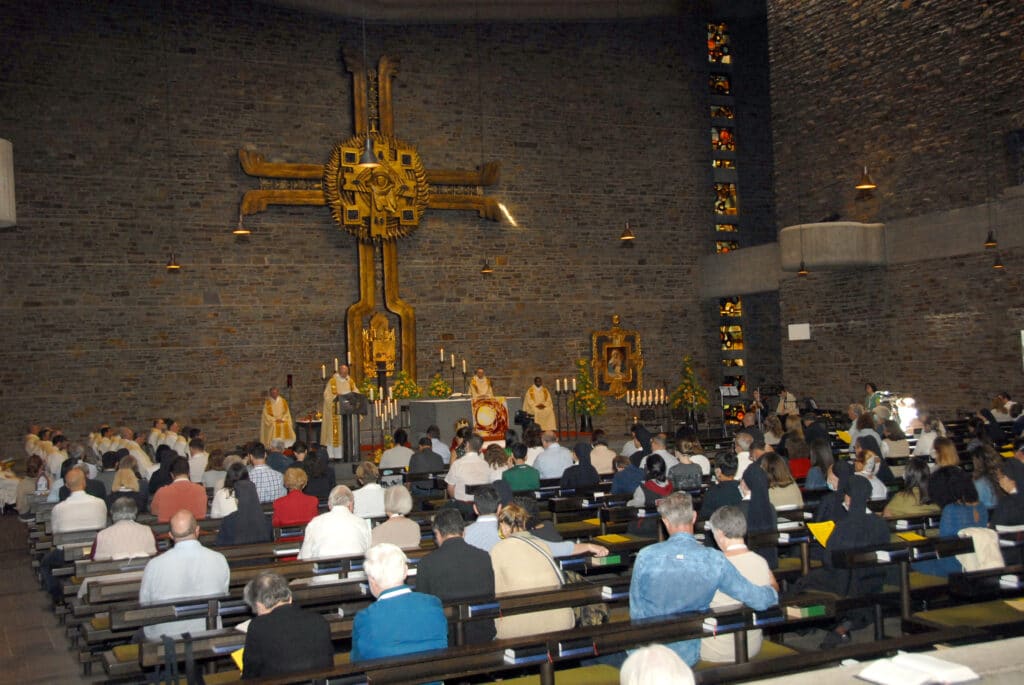
The Pentecost Congress closed with Sunday Mass, the celebration of the great feast of the Holy Trinity. Father Heinrich Walter presided, and he gave a homily reflecting on our shared experiences and mission from the Congress. These he expressed using three symbols.
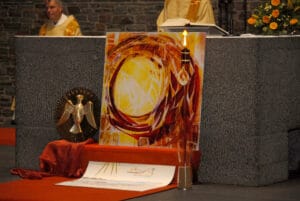
First, we entered our Pentecost Cenacle out of the swirling troubles of the world, the Church, and our own Schoenstatt family. We found refuge with our founder in the Founder Chapel and drew strength from the Holy Spirit who comes to us anew in this place, as symbolized by the Pentecost window.

Second, we are called to Synodality: “dialogue at all levels,” and the “co-creation of the new epoch.” This call is from the Hoy Father, Pope Francis, but it also was a part of Father Kentenich’s plan for Schoenstatt from the very beginning. Father Kentenich was rooted in the “new shore,” and we are called to step out of the arc of certainty and follow him toward the future of the Family and the Church. This is the second symbol.

Finally, the torch of the mission was passed on from the oldest generation to the newest. This symbolic gesture truly was an entrustment: they entrusted the future of Schoenstatt to the youth, and the youth accepted the responsibility and pledged themselves for the mission. This was an outward sign of the true inter-generational cooperation within the Schoenstatt family that has been characteristic of the proceedings of the Congress, as well as for the continuation of this cooperation into the future. It is also a symbol of the mission of Schoenstatt, to carry the light of Christ into the world as Church today.
“Oh Mother, Send Us Out From Here”
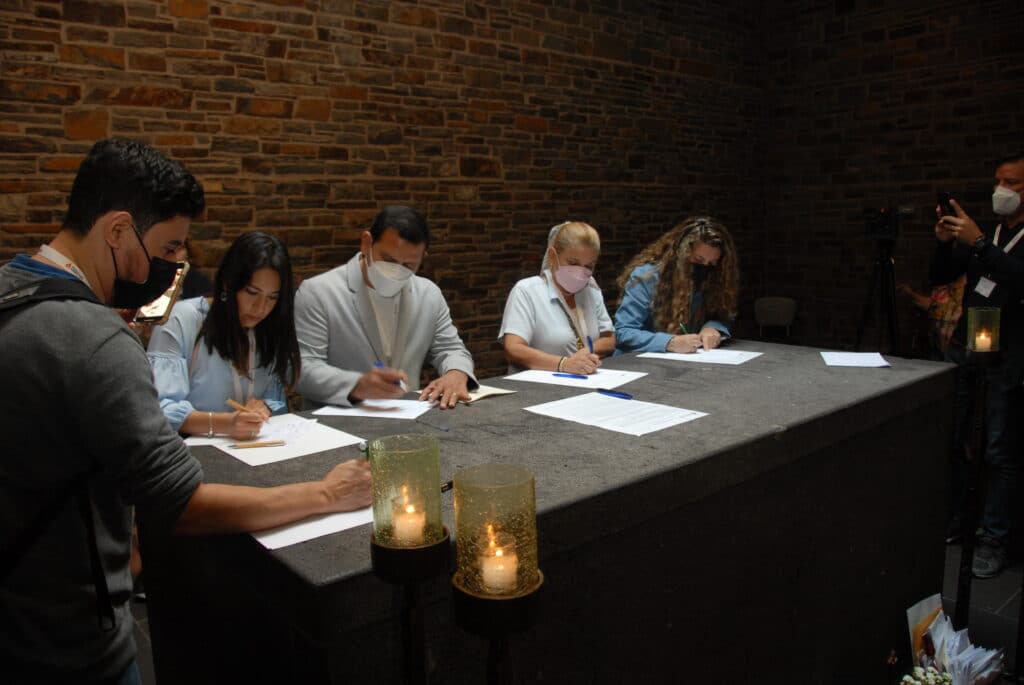
After the Mass, all of the participants entered the Founder Chapel once more, mirroring the beginning of the congress. There, they prayed and each took turns signing the memorandum.
The Pentecost Congress began with the feast of Mary, Mother of the Church, ended on Holy Trinity Sunday, and now the participants are going out to tell the whole world the good news!
A fraternal letter to the international Schoenstatt Family
Inspirations from the Day
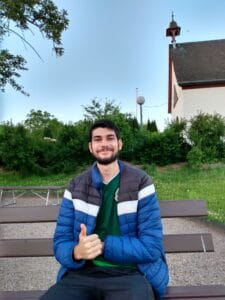
Jose Pablo Ramirez Carrasco, from the youth of Mexico, stated that he was impressed at how happy everyone was after the first read-through of the memorandum. Even though there were some questions and suggestions, it was a truly happy moment. He also remarked that Sunday Mass was in many different languages, most of the languages that people brought with them to the congress! He said that the Mass was "strange, but I liked it a lot." He was inspired at how happy everyone was at the end of the congress/ Everyone was able to make friends, and it was incredible to be on the other side of the world with all of these people. And this was what the congress was all about; the people were from everywhere but the shared "the same spirit, the same corpus." He remarked that this congress had a humorous Pentecost spirit: starting conversations was a leap of faith that the other person would speak one language in common with you. "Hello?" "Hola?" "Ah! Si!"
Looking to the future, Jose Pablo anticipates another congress in five years; this congress is only the second one, but after battling through the pandemic situation to make it happen, he has hope that these congresses will continue. From the congress itself, he said that every country can gain from it. Each country is different with their own struggles, but each can use the fruits of the congress in the way that they need.
Pentecost Congress: June 11 – Schoenstatt’s Charism and Calling
The fourth day of the Pentecost Congress dawned bright and clear, and everyone was glad of the morning coffee served before the first event of the day. Everyone could sense that this day would be the decisive day in the congress: the last day before the finalization of the memorandum.
Youth Pentecost
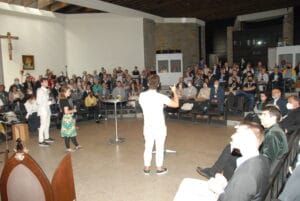
The first talk of the day came from three representatives of the youth at the congress. They and their companions had been working hard to prepare their own youth memorandum for the rest of the Schoenstatt family. There are many difficulties faced by the youth, but the biggest one is how disconnected they feel from the rest of the Schoenstatt family. They emphasized the need for representation in decision-making institutions, support from the whole family, and exposure and collaboration with the other branches of the family. They also pledged their strength and zeal to the family and the mission. The presentation was very well received, and many participants stated how delighted they were to see the maturity and zeal of the youth for their Schoenstatt family.
Schoenstatt’s Charism and the Church
Father Alexandre Ami Mello commented on the youth presentation at the beginning of his talk:
“We have to be proud of the youth. They just gave us an example of maturity, of how to treat deep themes but in such a simple way. They also have to live hard times, but they do it with real maturity because they have identified what comes in the future: looking at how to walk together with this family which they are proud of… The aim of the congress is to elaborate how God is moving Schoenstatt in the church and world today. If we do what the youth have proposed, half the work is done.”
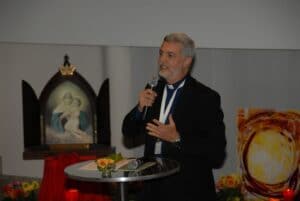
Father Awi Mello began his talk with this question: How can we help the world today as church, and what can we learn from today’s church and world? He stressed the importance of Schoenstatt being part of the Church, helping the world as Church. There is a danger of self-referentialism within movements like Schoenstatt, so he called us to remember that we are part of the Church. We must be proud of our family in Christ. “Without the Church, we do not exist, and only in the Church do we have the 'right to exist.’” The words on Father Kentenich’s tomb sum up his stance on this point: Dilexit Ecclesiam.
Working as Church, we are called to live our charism as Church in the world. We are called to be living transparencies of God, drawing close to others through humble listening and open dialogue. The laity is called to be active in all areas of society and to transform their daily work through their everyday sanctity; our quiet, daily piety is a powerful tool for evangelization. Finally, he reintroduced the point of Synodality which has been very important in the discussions this week. Schoenstatt is called to be synodal within itself but also with the Church, being active in the life of the Church. Rooted in the gospel and tradition, Schoenstatt looks towards the future.
Update from Reflection team and Discussions
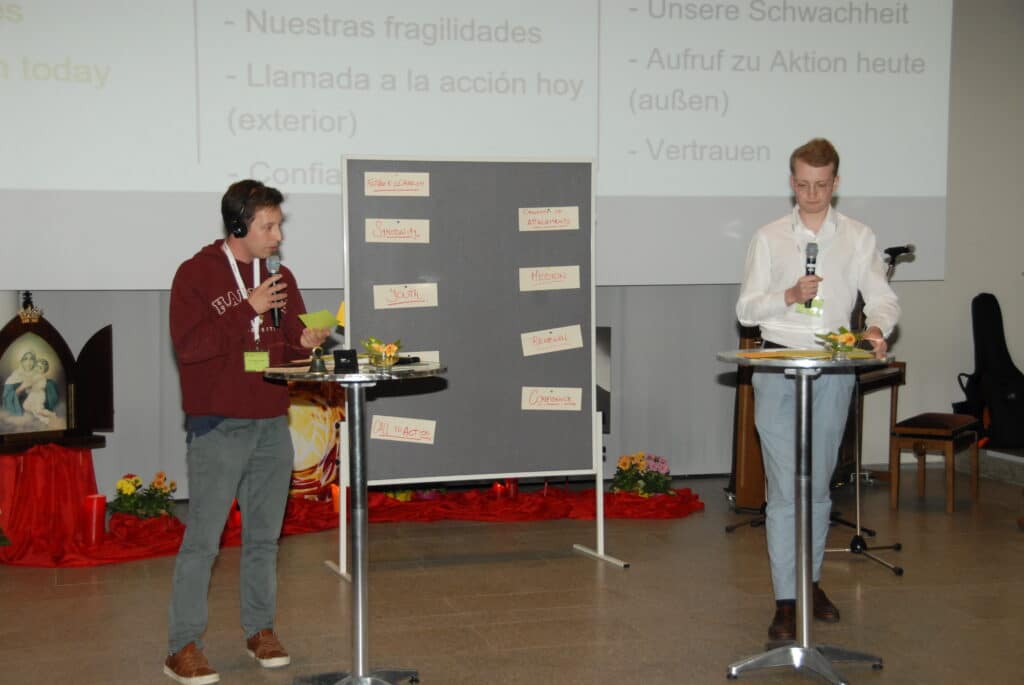
The morning continued with an update from the reflection team. They shared the main points they had synthesized from all of the discussions and suggestions they had collected throughout the congress. These points were:
- Father Kentenich and our charism
- Mission
- Renewal of the charism (internal)
- Call to action today (external)
- Youth as subjects (not objects)
- Synodality
- Organism of attachments
- Our frailties
- Confidence
After the speakers related these points and offered a brief explanation for each one, the participants broke off into their language groups to discuss the points. They wanted to come up with two words or phrases that summarized the most important aspects of all of the points. It was a very fruitful discussion, and the sixteen groups came back to the plenary discussion filled with ideas, hope, and enthusiasm.
Educated and Sent Out
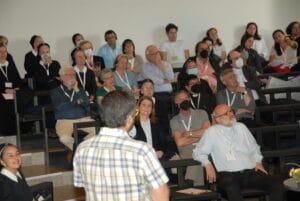
After lunch, there was a long break for coffee and discussions within countries and regions. There were many talks and discussions throughout the week, many ideas to process and many testimonies from different parts of the world. Each group wanted to formulate some strategies for implementing what they had learned here. America and Canada decided that they wanted to make a video about the youth's mini Pentecost Congress and about the memorandum when it was finalized. This plan was suggested to the whole congress as a potential international idea.
Relaxing River Rhine

The evening held a wonderful surprise: a boat trip on the Rhine river. It was a time for relaxation and community. The river was beautiful in the evening light, and there were historic buildings to look at on both banks. Everyone enjoyed the company, the food, and the music provided by the music team and the youth from Central and South America.
Inspirations from the Day
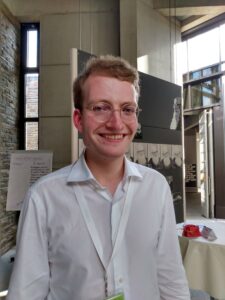
Tobias Zöhrer, from the youth in Austria, said that he could really feel that the Holy Spirit was present and speaking to every member of the congress. There was a deep connection between all of the participants like the congress was a family meeting; we felt like relatives coming together from all over the world. Tobias also enjoyed the discussions throughout the congress but particularly with the international youth. When the youth stayed up until the early morning hours before their presentation this morning, he said that they were able to formulate and complete the proposals because of our strong connections with each other. “We have the same goals.”
What particularly stood out to him from the day’s discussions was that the central point of our Schoenstatt charism is the Covenant of Love. The Schoenstatt family is called to be humble, focusing on our values and living them out with love and the willingness to learn from others.
Tobias hopes that we continue to grow strong as an international community, and that communication among the international youth will be fostered and strengthened. He hopes to stay in contact with the youth he met here and to share ideas, concerns, and life with them. Unity and diversity were the strengths that made the congress so fruitful, and what connected everyone was the shared mission of the family. He hopes that open dialogue will continue and be strengthened throughout the whole Schoenstatt family.
Pentecost Congress: June 10th - Schoenstatt and the Church
He stated that, when people talk about the church of the future, there are two main views: we want it to be like it was (radical traditionalism), or we want it to follow the progress of society (radical modernism). Traditionalism and modernism are two opposite extremes. These extremes reduce the Church to merely active projects, but neither of these are the church of Christ. The most important message of the church is the gospel: Christ came to give his life for us, to redeem us.
He also spoke about what Synodality means. Synodality means to talk with courage and listen with humility. It is the means that the Church is using to move towards actively embracing every human person. It is a movement towards continual renewal within the Church. Synodality was a key point of discussion throughout the rest of the day.
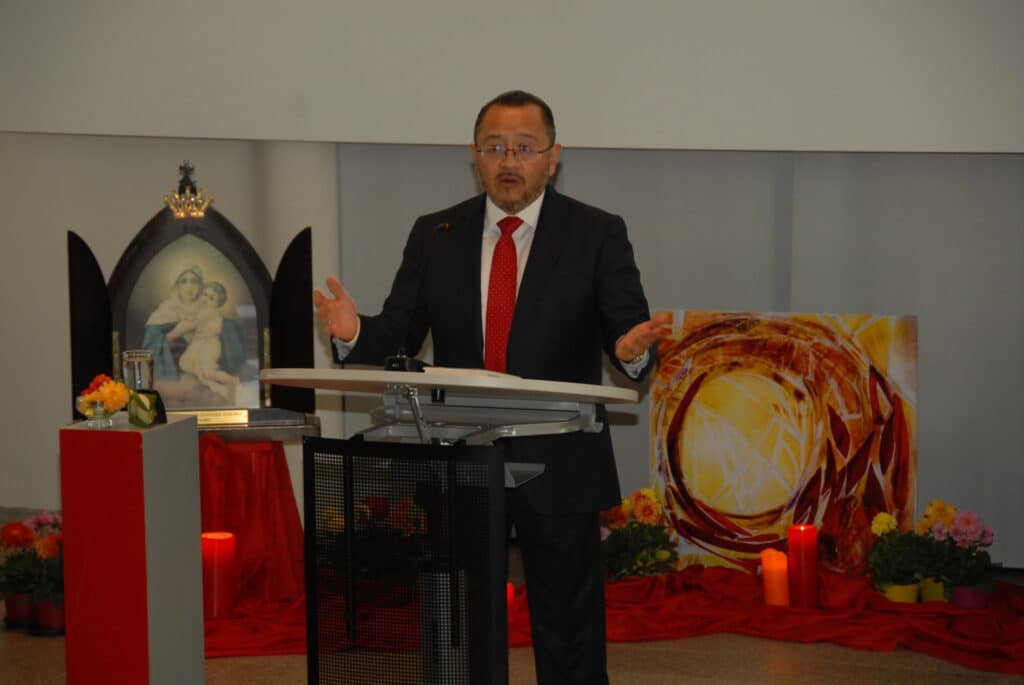
After a short break, Professor Guerra-Lopez returned to discuss the ecclesial and political path of the Church. He began by exploring the mission of the Church as seen from the beginning of Christianity. The mission of Christians is to live in the world and transform it from within. He compared Christians to the soul of the world; if the Christian leaves the world, the world begins to decay. This idea is wonderfully expressed in the ancient text a Letter to Diognetus.
He also emphasized the relatively new understanding of the importance of the laity in the great mission of the Church. As a lay movement, this is very important for our Schoenstatt family. He also stressed the relationship of Schoenstatt to the Church: Schoenstatt is in the Church and acts in the world as Church.
After Professor Guerra-Lopez’s talks, there was a time for the participants to ask him questions. There was a common theme of wanting to clarify the relationship of Schoenstatt to the Church. He answered that Schoenstatt is within the Church but that it should keep its identity and charism; Schoenstatt should draw from its Catholic roots and walk in the world as part of the Church.
Schoenstatt Goes Out
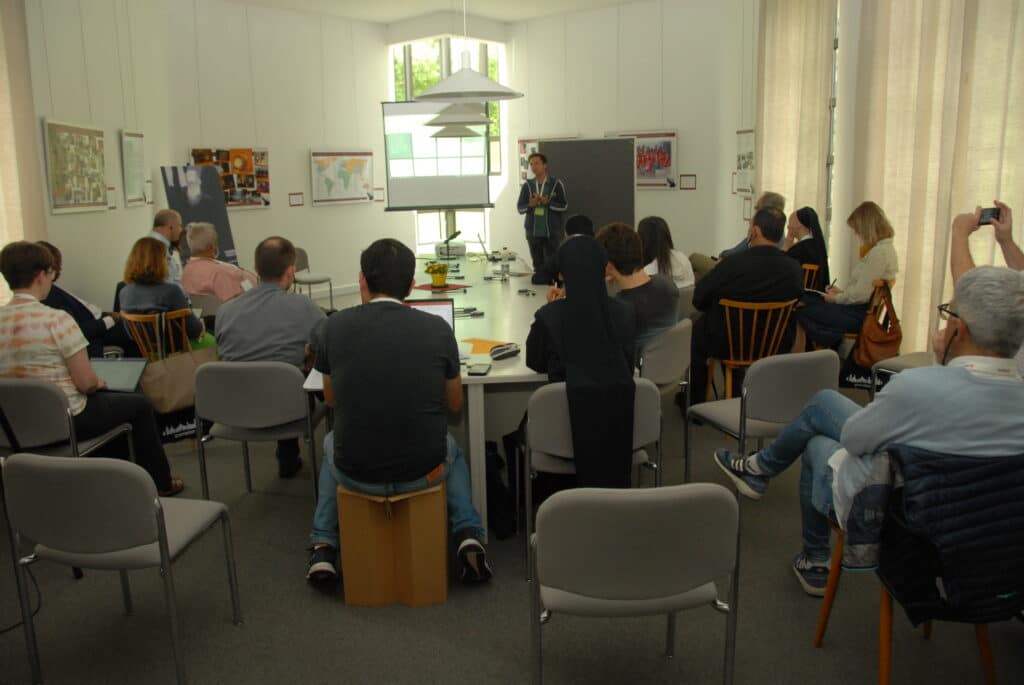
Once again, there were five discussions in the afternoon. Each participant chose one to attend.
- Power and Participation: Professor Dr. Mariano Pasquale Barbato
- Economics: Eduardo Jurado
- Education / Knowledge / Formation / Pedagogy: Laura Ramirez
- Spirituality: Luiz Carlos Susin
- Ecology / Future of Creation: Pedro Weizenmann

Come to Me
After supper and a long day of intellectual speeches and discussions, there was a peaceful time of guided meditation. The musicians played calming music and sang sweet songs in between short reflections and meditative pauses. It was a time to place all of the excitement and difficulties of the day into the Lord’s loving hands and simply rest in his presence.
The Bar
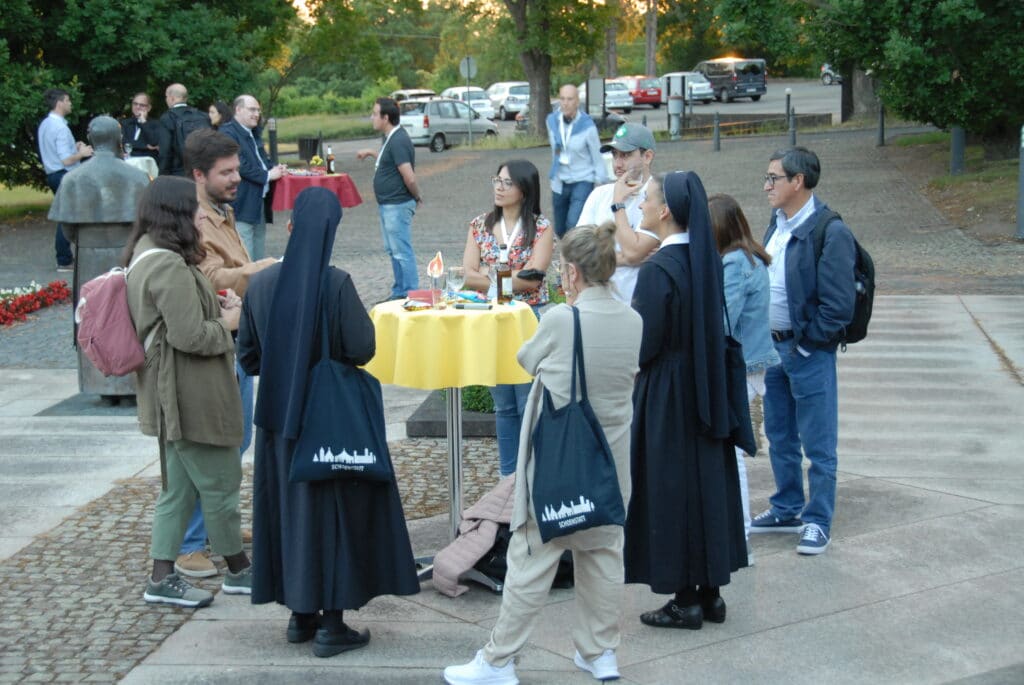
The evening closed with “Conversations at the Bar.” All of the participants were encouraged to socialize and chat with participants they hadn’t met before. There were beverages and snacks, and the atmosphere was inviting and laid back. Participants were encouraged to write what they learned from each other on little cards that were on every table, and those were shared with the reflection team afterwards.
Youth Congress
The evening didn't end there for the youth, however. They were hard at work into the early morning hours finalizing their proposals. They were getting ready to present the fruits of their mini Pentecost Congress to the rest of the Congress, and they were presenting first thing in the morning.
Inspirations from the Day

Silvia Granja, from the youth of Ecuador, was touched that the youth and older generations shared many similar perspectives on the topics discussed today. Throughout the day, she had many older participants coming up to her to offer her support; they were conscious of the struggles of the youth and were putting their trust into the youth being able to make changes for the better. She also loves that the spirit of the youth at the congress is very strong.
She hopes that the youth can exchange more with the older members of the family of Schoenstatt and communicate with each other in ways that leave good impressions. She hopes that the congress will set goals for a clear path for the future. “I am filled with hope.”
Pentecost Congress: June 9th -Spotlight on Father Kentenich
The second day of the congress opened with a four-part look at the state of the cause for Father Kentenich. Doctor Gertrud Pollak introduced the topic by defining that “cause” is a legal term, a term for this legal dispute and is all about information and argumentation. It is a snail-like process, and we must accept the snail’s pace.
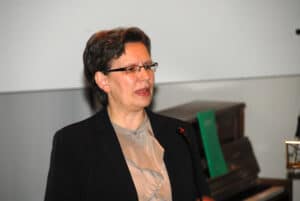
Sr. M. Veronika Reichel gave an overview of the current state of the cause for Father Kentenich’s canonization. The movement was hit by several shockwaves over the past two years concerning allegations of abuse, negative reporting about Father Kentenich, and then the suspension of the cause for his canonization. Currently it is suspended but not terminated. She stated that this topic must be discussed; we cannot and do not want to hide it but desire to resolve it. In response to these shockwaves, the International Schoenstatt Movement has taken these steps.
- First, a media commission was set up in 2020 to coordinate public work, and now it also works to address questions related to the cause and strives to reestablish Father Kentenich’s credibility.
- Second, there are committees doing intense research into the life, teachings, and person of Father Kentenich. These committees are on differet levels: the Roman level, using documents from the Vatican archives; the international level, which is a team of researchers from within Schoenstatt; the community level, which is an intensified study of documents from the Sisters’ archives; and finally the scientific level, which is a brand new initiative and is still in development.
- Third, there are many educational seminars and events within Schoenstatt that aim to teach the family more about Father Kentenich’s life, teachings, and person.
- Fourth and finally, the Schoenstatt Sisters of Mary took legal action against the author and publisher of the book “Father Can Do That.” Ultimately, their application was rejected by the German courts for this reason: “freedom of science must be given a wider scope and scientific freedom also covers the irrational.” It also stated that his innocence has not yet been proven. Finally, the court did not consider the allegations of abuse as an attack on his character or as defamation.
Sister Veronika reminded the participants that this struggle is all “an adventure between heaven and earth.” Ultimately, the Blessed Mother will take care and be victorious.
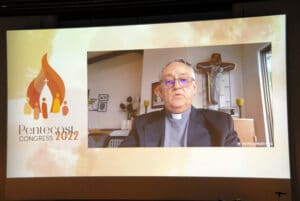
Father Eduardo Aggirre, the postulator of Father Kentenich’s cause, stated that one great consequence of this difficult situation is that serious efforts are being made to investigate Father Kentenich’s work and actions. This helps us to understand and elaborate the mission or charism of Schoenstatt and Father Kentenich’s life.
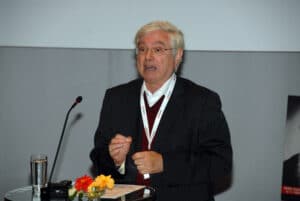
The third speaker, Professor Brantzen, spoke about the circumstances behind Father Kentenich’s exile and how all of those things eventually lead to this moment in time. He has many educational materials about these topics which shed light on these difficult parts of Schoenstatt’s history and present. There were many actors involved in the conflict then, and the problems arose because of their clash in values and understanding of the future of the church.
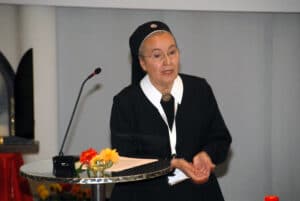
Finally, Sister Elizabeth Parodi discussed the importance of understanding the charism of Schoenstatt within the Church. She stated that Schoenstatt was born within an existing order, the Pallottines, and at the brink of a paradigm shift within the church. Father Kentenich looked to the “new shore,” but the church was still anchored in the old. This process of researching the founder’s life, teachings, and person must try for a synopsis of the charism of Schoenstatt as well, for the good of the movement and in its relation to the Church.
There are some short articles concerning Father Kentenich's cause on this website.
A Glimpse of Schoenstatt in Society
In the afternoon, the participants were able to attend a few different workshops. There were five scheduled workshops.
1. Synodality in Schoenstatt
2. Schoenstatt’s presence and effectiveness in society
3. Schoenstatt’s Pedagogical influence in society
4. Kentenich Intensive Course
5. Synodality in the Movement
Youthful Pentecost
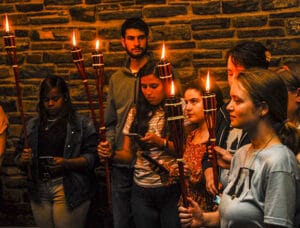
There was another workshop which was added to the schedule earlier in the morning: a mini-Pentecost for the youth. This meeting was for the whole afternoon, and only youth and two moderators, a priest and a Sister, were invited. It was an opportunity for the youth to discuss their place in the movement, how they see themselves and how they relate to the rest of the family. The goal of the meeting was to formulate concrete goals and expectations to propose to the congress and to put into the memorandum as action points for the coming five years. More information about their ideas and proposals will be released over the weekend, once they have concluded their discussions.
Handing on the flame
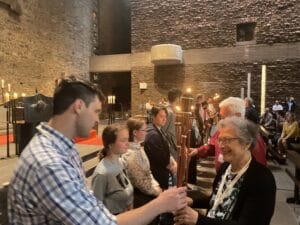
The day ended in the Adoration Church with a time of community prayer and adoration. There was a beautiful ceremony of passing the torch of Schoenstatt to the next generation. The older generation passed on literal torches to the youth, but these torches are symbolic of the mission of Schoenstatt. Then the youth sang from the zeal in their hearts and declared, "Here I am."
Inspirations from the Day
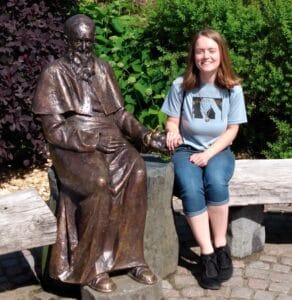
Kayla Doll, from the youth of the USA, shared her impressions from the talks about Father Kentenich. “Schoenstatt and each individual, in order to live the mission, needs to ask the question: who is father (Kentenich) for me?” This question is important because he is inseparable from Schoenstatt because he is one of the three contact points in the covenant of love. If we don’t stand by him, we will fail. He and the Blessed Mother have the answers to the needs of our times; it’s just a matter of “conjugating” them into the present tense, into the present time.
She was also struck by the greatness of our mission in Schoenstatt. “It’s exciting and terrifying and if we try to do it alone, we will fail… But, Mother takes perfect care and is victorious.” Kayla’s hopes for the congress are that people will be open, will let the Blessed Mother and Father Kentenich lead them. She hopes that people will be open to each other in their conversations and will acknowledge the difficulties of working together as a family so that we can work on them together. She hopes that everyone will not get hung up on their differences or disagreements but will trust that Father Kentenich and the Blessed Mother will lead the family.
Pentecost Congress: June 8th - Come Holy Spirit
The Pentecost Congress opened on June 8th at 11:00 am with holy Mass at the Original Shrine. It was an international Mass celebrated in German, English, Spanish, and Portuguese. There are about 150 participants from about 30 countries attending the congress. It was lightly raining throughout Mass, but the atmosphere was light and full of joyful hope and expectation.
A New Pentecost for Schoenstatt
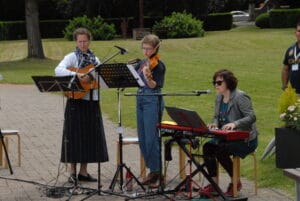
In his homily, Father Juan Pablo Catoggio spoke about Pentecost as an event that perpetually repeats not only throughout the liturgical year but in the Church and in Schoenstatt. It brings about new life. He said that we need Pentecost. In particular, we need:
· “The Spirit of holiness who transforms and renews us
· The Spirit of love who unites and holds us together in freedom and solidarity
· The Spirit of mission that sends us out and makes us fruitful for the world.”
These movements of the Holy Spirit remind us of the main keywords from the Pentecost congress of 2014: holiness, attachments, and mission. Father Catoggio prayed that this congress would bring about a “new Pentecost” for Schoenstatt and for the Church and the whole world.
Father Catoggio's Homily in English
A World-Wide Movement
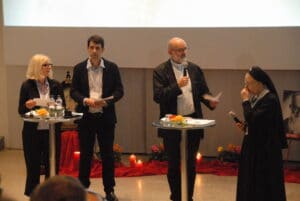
After Mass, the congress reconvened at 2:00 pm (14:00) for a social hour in the Father Kentenich House. This was an opportunity for the participants from different countries to interact with each other and begin to make connections and open channels for discussion.
The opening address of the congress began at 3:00 pm (15:00) and was called Moved by the Spirit of God. Father Heinrich Walter stated two of the biggest crises that the world is facing today, the pandemic and the war in Ukraine, and how insecure these have made people feel. However, he said that the Blessed Mother gave the participants the gift to be able to come together for the congress and that she is helping them in this important work. She is the one who is most interested in this congress, and she intercedes the Holy Spirit for them.
As the hosts of the congress, Richard and Ingeborg Sickinger and Father Jose Luis Correa, introduced each country, all of the participants were able to express their pride in their native countries and in Schoenstatt as an international movement.
The hosts also introduced the International Coordination office and the Continental Coordination office of South America and the important work they have been doing. The International Coordination office represents the Schoenstatt Movement in international events worldwide, such as in large church events, answering important questions in Rome, and many other things. Both offices have the tasks of improving communications and coordinating the life of the movement between the different branches of Schoenstatt internationally and within South America, respectively. This is difficult work, and these offices expressed the need for full-time, committed workers to help them in their missions.
International Exchange of Hopes and Questions
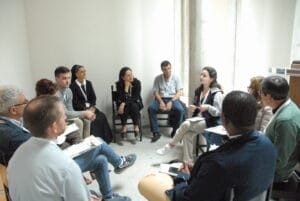
There was a time in the afternoon for open discussion among small groups of participants who speak the same language. These groups wanted to answer the questions: what moves us, and what are our personal desires and longings for the congress. The key themes that came out of these discussions were connected to Father Kentenich, confidence in and renewal of the Schoenstatt Spirituality, hope and joy for the work of the congress and to be spread to others, and the participants’ desires looking forward to the future of the movement such as direction, renewal, instrumentality, internationality and diversity, complementation, bonds and united forces, and the continuation of fruitfulness.
A Momentous Occasion
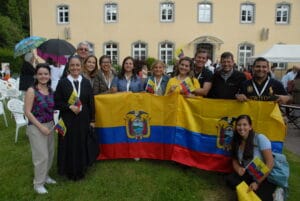
The congress is an occasion for international discussion and sharing. Father Heinrich Walter compared this movement-wide congress to the church-wide congresses of the Vatican councils. It is a time for coming together to grow in communication, international relationships, and understanding, and of combining the Pentecost zeal of each country to form a huge Pentecost fire for Schoenstatt. It is a time to review what the past of Schoenstatt was and the direction that the signs of the times and Divine Providence are leading the movement. It is a time to make a vision for the next phase, the next century of Schoenstatt.
At the end of the congress, a formation team will synthesize all of the themes, decisions, and fruits of the congress into one memorandum. This document will be sent to every Schoenstatt community around the world, to every country, as a useful tool for the future and as a sign of hope and renewal of zeal for the Schoenstatt movement in every corner of the world.
The day closed with prayers to the Holy Spirit for his help and guidance and a visit to the Founder Chapel, to our Pentecost room.
Inspirations from the Day

Sister Connie O’Brien, from South Africa, shared that this congress is a wonderful representation of the internationality of Schoenstatt and an opportunity for deeper communication between countries. She had hoped that those who prepared for the congress would have proposed themes beforehand and incorporated the suggestions and feedback of the participants. However, she hopes that, as the congress continues, there will be many more opportunities for discussion about themes that were not included in the schedule such as the modern identity crisis, particularly among the youth, and Schoenstatt’s accessibility for young people. She stressed the importance of active involvement of participants in the planning of their own events as a powerful tool of education and a great means of improving the engagement of the participants in the events. So, she hopes that the creative adaptability of the congress in its topics and schedule will serve as a learning curve for the next congress. She looks forward to the discussions and proposals related to the youth so that she can bring home new inspirations and helpful tools for connecting with them and helping them do discover the answers to the big questions: Who am I and what is my purpose?

“It was cool! I was nervous, at first, because I thought that I was going to be the only teenager but plot twist!” Santiago Pierobon, from the youth of Argentina, was delighted to see how many young people are attending the congress. The environment in the congress was very uplifting and fertile for making new friends. He was also impressed by the open-mindedness of the older participants at the congress: “Teens can be heard!” He shared that in Argentina it is nearly impossible for the youth to feel heard and understood. He was also pleasantly surprised that the idea of updating certain aspects of Schoenstatt education and terminology was brought up first by the older participants. He looks forward to discussing the future of the youth in Schoenstatt: “They need to be heard and independent.” Also, he hopes to discuss the educational materials, particularly for high school aged youth, which need to be updated and made more accessible to the youth of today. He hopes for the normalization of discussing and debating concrete ways to respond to the difficult questions that permeate society. He said that we need to be “awake to our society.”
World Youth Day: Lisbon will host from August 1-6, 2023
According to a press release from the organizers, the announcement was made today, Monday, October 4, the feast of St. Francis of Assisi. It is very important for the youngsters to know the date in order to begin the coordintion of the Day, reads the text.
“We hope that the 22 months leading to the World Youth Day will be a time of evangelization for all”, says Manuel Clemente, Cardinal Patriarch of Lisbon. Presently, the working groups that make up the Local Organizing Committee (LOC), the executive body in charge of the preparation and organization of WYD Lisbon 2023, already have more than 400 volunteers, most of them Portuguese. In each of the 21 dioceses of Portugal there are also Diocesan Organizing Commissions, in charge of promoting the preparations for WYD.
The communiqué reports that last year, the most important highlights were the launch of the official WYD image in October 2020, the welcoming of the WYD symbols in Rome in November 2020 during a celebration with Pope Francis, and the announcement of the official WYD anthem in January 2021.
https://www.youtube.com/watch?v=HxtO3xtybOw&t=14s
World Youth Day since St. John Paul II
World Youth Day (WYD) is an event that goes around the world and was established by Pope John Paul II in 1985. Since then, it has distinguished itself as a time of encounter and fellowship for millions of people around the world.
The first edition was held in 1986 in Rome, and since then it has been held in the following cities: Buenos Aires (1987), Santiago de Compostela (1989), Czestochowa (1991), Denver (1993), Manila (1995), Paris (1997), Rome (2000), Toronto (2002), Cologne (2005), Sydney (2008), Madrid (2011), Rio de Janeiro (2013), Krakow (2016) and Panama (2019).
On January 27, 2019, in Panama, during the celebration of World Youth Day, Cardinal Kevin Farrel, Prefect of the Dicastery for Laity, Family and Life, announced that Lisbon would be the next city to host the event. Originally scheduled for the summer of 2022, WYD Lisbon was postponed by one year due to the Covid-19 pandemic.
Source: Vatican News

